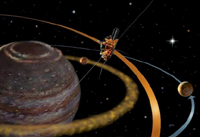Orbit/Navigation
A polar orbit around the Sun can be achieved, however, by taking advantage of a gravity assist by another planet. During a gravity assist manoeuvre some of the planet's angular momentum (from its orbit around the Sun) is transferred to the spacecraft during a fly-by. This is governed by the law of conservation of angular momentum. What the space probe gains in momentum, the planet loses. Because the mass of the planet is huge compared with that of the spacecraft, the change in the planet's velocity is imperceptible - it is smaller than the change in the spacecraft's velocity by a multiplication factor equal to the ratio of the spacecraft's mass over the planet's mass.
Jupiter Fly-By - Injection into Operational Orbit
 |
|
Artist's impression of Ulysses swinging by Jupiter (D. Hardy) |
After sixteen months of interplanetary cruise, Ulysses arrived at the Solar System's largest planet. The closest approach occurred at 12:02 UT on 8 February 1992.
Following the fly-by of Jupiter, the spacecraft entered an elliptical, heliocentric orbit inclined at 80.2° to the solar equator, with an orbital period of 6.2 years, aphelion at ~5.4 AU from the Sun and a perihelion distance of ~1.34 AU.
The orientation of the orbit is such that Ulysses passes first over the Sun's south pole, followed by the Sun's north pole roughly one year later. Since the beginning of the mission, Ulysses has completed two orbits of the Sun and is now far in its third orbit, which started after the spacecraft reached its third aphelion in June 2004.
The Polar Passes
The Ulysses polar passes are defined to be those periods during which the spacecraft is above 70° heliographic latitude in either hemisphere. The mission was designed to maximise the total duration of the polar passes, with a minimum requirement of 150 days. The actual mission performance is significantly better than this and during the first four polar passes the spacecraft spent a total of 468 days above the 70° heliographic latitude limit.
In March 2008, Ulysses completed its sixth polar pass (third north polar pass).
| Polar Pass | Start date | Maximum latitude | End date | |||
| 1st South | 26 Jun 1994 |
|
05 Nov 1994 |  | ||
| 1st North | 19 Jun 1995 |
|
29 Sep 1995 |  | ||
| 2nd South | 06 Sep 2000 |
|
16 Jan 2001 |  | ||
| 2nd North | 31 Aug 2001 |
|
10 Dec 2001 |  | ||
| 3rd South | 17 Nov 2006 |
|
03 Apr 2007 |  | ||
| 3rd North | 30 Nov 2007 |
|
15 Mar 2008 |  |
After more than 17 years of operations, since launch in October 1990, the mission is now nearing its end. The spacecraft is succumbing to the cold conditions in space, with the gradually declining power output from the RTG and with the heaters no longer able to prevent the freezing of fuel lines. Science operations will however continue to the very end.
It should be noted that Ulysses's out-of-ecliptic trajectory enables a survey to be made of all magnetic latitudes, since the inclination of the Sun's magnetic dipole axis with respect to its rotation axis is generally greater than 10°.
Science Operations
In the normal operating mode, the scientific data acquired by the Ulysses instruments are stored by a tape recorder on board the spacecraft for approximately 16 hours and downlinked to the NASA Deep Space Network once a day together with the real time data during a nominal 8-hour tracking pass. The coverage to date has been excellent, being ~97% on average over the mission. This data base represents the most complete set of continuous interplanetary measurements ever recorded.




